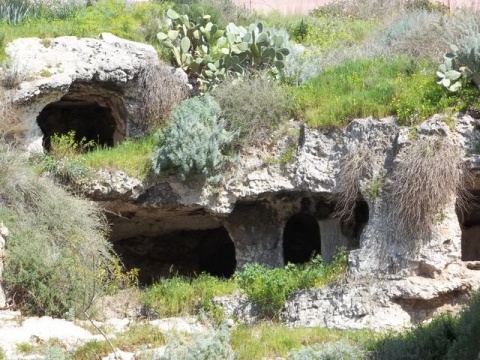The Hill of Tuvixeddu, which gives its name to the surrounding Punic necropolis, is located between the Sant'Avendrace and San Michele districts. The Tuvixeddu necropolis, which extends over the whole hill, is the largest Phoenician-Punic necropolis still existing in the Mediterranean basin. The name derives from the Sardinian "tuvu" which stands for cavity, due to the presence of numerous tombs carved into the limestone rock. Between the VI and III century BC the Carthaginians chose, indeed, the hill as a sacred place where they could keep the bodies of the dead: these burials were reached through a well dug entirely in limestone and deep from two and a half meters up to eleven meters. Inside the well a small opening led to the actual sepulchral cell where the deceased was deposited with the ritual outfits. Amphoras and ampoules were found in the funeral chambers which contained perfumed essences. On the slopes of the Hill of Tuvixeddu there is also a Roman necropolis, that overlooked the road which, at the exit of the city, became the Karalibus Turrem (today's Sant'Avendrace avenue). Both the Carthaginians and the Romans used the hill for water needs.
With the arrival of the Vandals and the Byzantines other burial systems came into use and the necropolis was abandoned.
In 1258, after the destruction of the city of Santa Igia by the Pisans, the survivors settled in the current Sant'Avendrace Avenue, on the slopes of the hill: so most of the houses leaned against Tuvixeddu, each of these using an access to the caves. Even today, in case of demolition of the old houses, caves are often found with evident signs of residential use (some of these caves can be seen behind the Siotto High School).
In the mid-nineteenth century the hill was perforated and dismembered and the cavities were blown up; its original appearance was thus erased forever. In the twentieth century it became the quarry of an Italcementi cement plant, which completed its extraction only in the eighties. Many tombs with the quarry works were irreparably destroyed, even if others were found. In addition, during the Second World War the caves were used by the inhabitants of the area as air raid shelters and as homes. In the immediate post-war period they were used by those who had lost their homes during the bombing.
Colle di Tuvixeddu
Colle di Tuvixeddu
Via Is Maglias - Via Vittorio Veneto
City
CagliariAdd new review
Your review will be visible after approval by the editors
To post a review you must be an authenticated user.
Log in with Social Login
